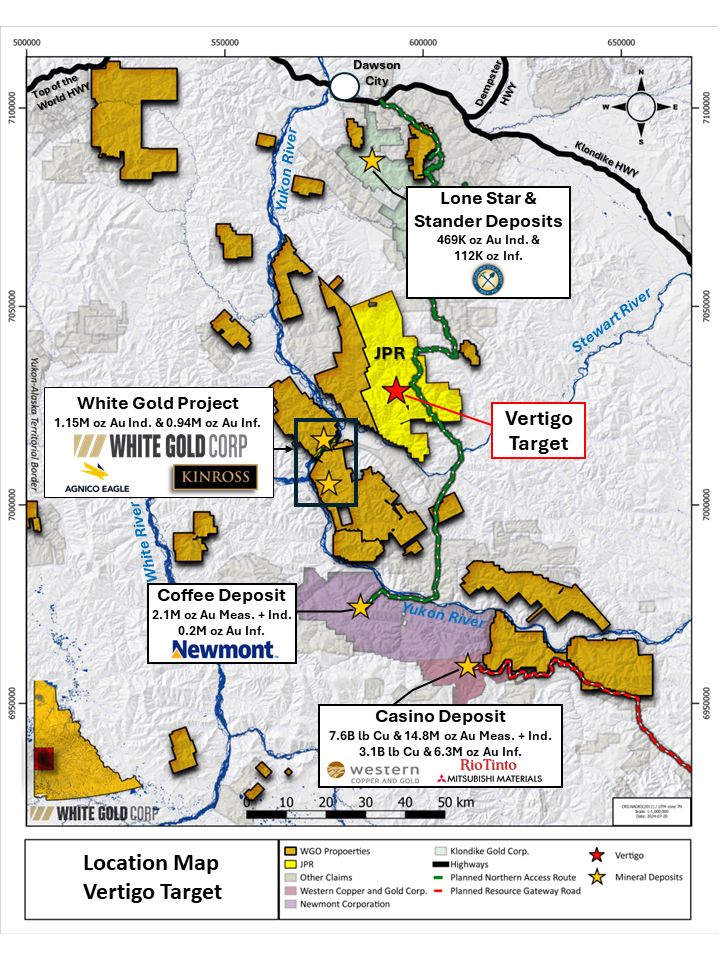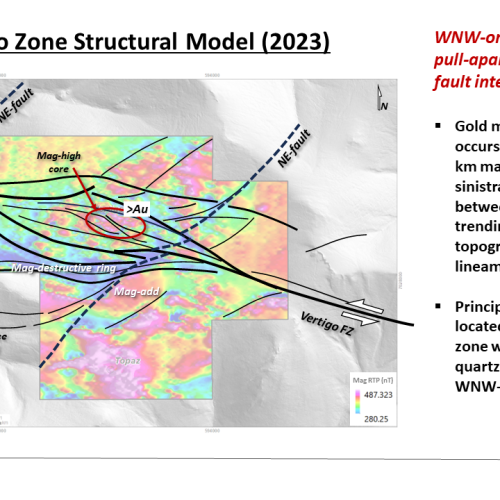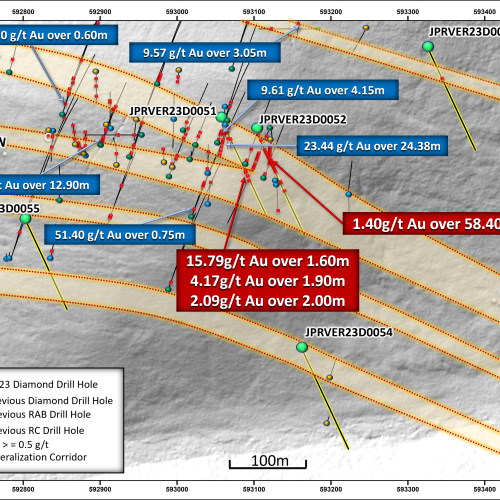Location & Access
The Vertigo target is located in the central part of the JP Ross property approximately 75 km south of Dawson City and 360 km northwest of Whitehorse in west-central Yukon. The Property is road accessible from Dawson City. Additionally, the Henderson airstrip located 6.5 km to the west provides small fixed-wing plane access.
Size
2,849 claims covering approximately 57,100 hectares
Work to Date
Soil sampling, GT Probe sampling, airborne and ground geophysics, LiDAR, geological and structural mapping and interpretation, mechanical trenching, RAB, RC and diamond drilling
Target (Mineralization)
Orogenic gold deposits
Qualified Person
Terry Brace, P.Geo. and Vice President of Exploration for the Company is a “qualified person” as defined under National Instrument 43-101 – Standards of Disclosure of Mineral Projects and has reviewed and approved the content of this project summary.
Overview
The Vertigo target comprises at least 6 mineralized structures over a 1,500 m x 650 m area and consists of west-northwest striking, steeply south dipping zones of quartz veining, brecciation, and fracture-controlled mineralization comprising disseminated to vein-controlled semi-massive sulphides including arsenopyrite, galena, pyrite, along with visible gold locally.
Vertigo was first identified as a prospective target area by Underworld Resources Inc. (“Underworld”) in 2009 through early-stage soil geochemistry sampling and geological mapping and prospecting, with rock chip samples of quartz veins returning 1.3 g/t Au. In June 2010, Kinross Gold Corporation (“Kinross”) acquired Underworld and continued exploration on the JP Ross property, including the Vertigo target. Exploration work on Vertigo in 2010 included additional soil sampling, prospecting and surface rock sampling, mechanical trenching (10 trenches, 698 m) and diamond drilling (4 holes, 521.7 m). Prospecting confirmed the presence of gold in quartz vein float, with two grab samples returning 5.37 g/t Au and 8.08 g/t Au. Chip sampling of trenches returned anomalous gold generally ranging from 0.10 to 0.20 g/t Au over widths of 5-30 m, with a best interval of 1.05 g/t Au over 45 m, including 4.06 g/t Au over 10 m in trench JRVE10T0008. Diamond drilling intersected relatively narrow (1-2 m) mineralized zones of generally low grade (< 0.5 g/t Au). The best interval was in hole JRVE10D0003 which returned 17.85 g/t Au over 1.0 m in a vuggy quartz vein and silicified breccia zone from 103.0-104.0 m.
In June 2017, the Company acquired all of Kinross’s projects in the White Gold District including the JP Ross property. In 2018 and 2019, the Company carried out extensive drilling programs on the Vertigo target which included rotary-air blast (RAB) drilling (1448.9 m in 25 holes), reverse circulation (RC) drilling (2551.3 m in 36 holes), and diamond drilling in 2019 (9568.5 m in 46 holes).
Highlights of the RAB and RC drilling included:
RAB Drilling:
-
JPRVERRAB18-001: 12.25 g/t Au and 10.25 g/t Ag over 15.24 m from 1.52 m
-
JPRVERRAB18-011: 8.11 g/t Au and 7.13 g/t Ag over 18.29 m from surface
-
JPRVERRAB18-014: 23.44 g/t Au and 144.75 g/t Ag over 24.38 m from surface
RC Drilling:
-
JPRVERRC18-006: 9.46 g/t Au and 36.68 g/t Ag over 22.86 m from surface
-
JPRVERRC18-009: 14.23 g/t Au and 26.58 g/t Ag over 6.10 m from surface
-
JPRVERRC18-013 (twin of RAB hole JPRVERRAB18-014): 18.59 g/t Au and 188.75 g/t Ag over 6.10 m from 24.38 m
-
JPRVERRC18-016: 9.20 g/t Au and 14.68 g/t Ag over 9.14 m from 54.86 m
The 2018 RAB and RC drill holes were drilled to both the south (180° azimuth) and north (0° azimuth) at dips of -55° to -65°. This initial round of drilling confirmed that the primary mineralized structures are dipping steeply to the south, hence all 2019 RAB and RC holes were drilled to the north (0°-20° azimuth). It is apparent that the 2018 RAB and RC holes that were drilled to the south drilled partially down-dip on the mineralized zones, thereby exaggerating the thicknesses.
Diamond Drilling:
The 2019 diamond drill holes were drilled predominantly to the north-northeast (020° azimuth) to test the interpreted steep southerly dip. Highlights included:
-
JPRVER19D005: 9.61 g/t Au and 32.67 g/t Ag over 4.15 m from 20.0 m
-
JPRVER19D015: 11.64 g/t Au and 31.68 g/t Ag over 5.34 m from 3.0 m and 18.46 g/ Au and 23.90 g/t Ag over 2.48 m from 92.0 m
-
JPRVER19D016: 6.26 g/t Au and 21.70 g/t Ag over 5.60 m from 4.00 m
-
JPRVER19D043: 1.36 g/t Au and 4.73 g/t Ag over 18.25 m from 22.75 m
-
JPRVER19D049: 3.93 g/t Au and 23.41 g/t Ag over 12.90 m from 29.70 m
-
JPRVER19D050: 0.85 g/t Au and 4.89 g/t Ag over 55.05 m from 49.20 m
Since 2019, exploration work at the Vertigo target area has been limited. In 2020, 6 trenches were excavated as part of a phase 1 and phase 2 trenching program on the JP Ross property. During phase 1, an 8-ton tracked excavator dug 4 trenches at Vertigo and during phase 2, a small CanDIG mini excavator dug 2 trenches. The phase 1 trenches exposed narrow mineralized oxidized and vuggy quartz veins which graded 4.51 g/t Au over 1.5 m in trench JPRVER20T016, 0.91 g/t Au over 2.0 m in JPRVER20T017 and 2.78 g/t Au over 1.8 m in JPRVER20T018. Phase 2 trenching produced the most encouraging results with trench JPRVER20T020 returning 2.16 g/t Au over 21.0 m which included two higher grade subzones of 5.69 g/t Au over 3.0 m and 4.15 g/t Au over 5.0 m. The trench ended in mineralization to the south, so the zone remains open in that direction. This latter mineralization is associated with a southeast-trending gold-in-soil anomaly that remains open along strike to the southeast. Also in 2020, a single RAB hole was drilled at Vertigo with hole JPRVER20RAB-026 intersecting a zone grading 1.82 g/t Au over 3.05 m from 1.52 m.
More recently the Company has reviewed and interpreted available borehole optical televiewer and trench structural data which indicates that there are 3 mineralized vein sets at Vertigo: 1) the primary WNW striking vein set which has been the focus of previous drilling; 2) a north-northeast (022°) striking secondary vein set which dips steeply to both the west and east; and 3) a set of narrow (up to 10-15 cm) sheeted quartz veins that strike east-northeast (070°) and dip moderately at 55° north. These latter quartz veins were exposed during mechanical trenching during the 2019 field season, and vein samples returned encouraging gold assays in the range of 1.5 g/t Au to 17.3 g/t Au, however 2019 diamond drilling did not test this newly identified vein set due to the orientation of drilling.
Assay results for the 2023 Vertigo diamond drilling program are summarized below in Table 3. Hole JPRVER23D052 produced the most encouraging results intersecting 58.4 m grading 1.4 g/t Au from 40.95 m downhole, with narrower high-grade subintervals of 9.10 g/t Au over 2.85 m and 6.68 g/t Au over 4.80 m. This hole confirms that Vertigo locally contains relatively broad zones of bulk tonnage gold mineralization. Hole JPRVER23D051 was collared approximately 50 m west-northwest of JPRVER23D0052 and intersected 3 discrete gold mineralized zones grading 4.37 g/t Au over 1.30 m, 15.79 g/t Au over 1.60 m, and 4.17 g/t Au over 1.90 m. Intervening intervals between mineralization did not return any significant gold values, suggesting a variation in vein density and structure between the two holes.
Hole JPRVER23D053 was drilled approximately 250 m east-northeast of hole JPRVER23D052 to test a gold-in-soil anomaly and intersected a single narrow zone grading 2.77 g/t Au over 1.90 m from 64.45 m depth. Holes JPRVER23D054 and JPRVER23D055, drilled to the south and west-southwest to test additional gold-in-soil anomalies did not encounter significant mineralization.
The 2023 diamond drilling successfully identified two primary fault and vein arrays that strike WNW and NE. The higher concentration of gold in hole JPRVER23D052 is closely associated with an increase in vein and breccia structures in the hanging wall of a major fault zone which appears to strike WNW. The highest gold grades (5.5 – 15.6 g/t Au) are associated with multiple phases of quartz-pyrite and quartz-arsenopyrite which is hosted in brittle-ductile vein sets and crackle and hydrothermal breccias. Additional review of the 2019 drill core and other data (geochemical & geophysical) is expected to aid in refining the structural interpretation for future drill targeting.
Additional surface targets on the project remain to be drill-tested, and Vertigo has seen only relatively shallow drilling, so opportunities exist for the discovery of additional high-grade gold zones.
Note: All reported widths are those measured along the length of the drill hole and/or trench. True widths are currently unknown.




